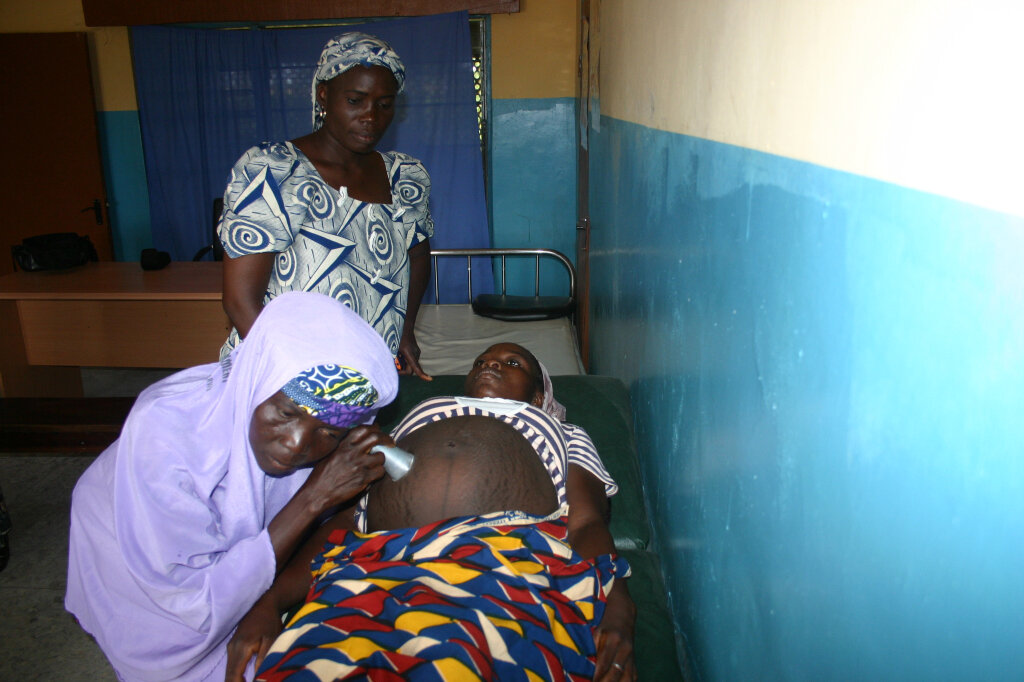The Power Is In Our Hands: Fetal Heart Monitor Uses Human Energy to Save Lives
Image: “TBA Hauwa Saliu listens to fetal heart sounds under the supervision of Faustina Ajayi, a nurse-midwife” by CDC Global. CC 2.0
Four million newborn deaths occur in developing countries every year, where access to health care can be low or, in some cases, virtually non-existent. Furthermore, of all child deaths under the age of 5 that occur annually, nearly 40% are among newborns during their first 28 days of life.1 The vast majority of these deaths can be prevented, and complications for mothers and newborns can be minimized if skilled health workers perform effective monitoring during pregnancy, childbirth and the postnatal period.1,2 Healthcare workers need vital information obtained from fetal monitoring to detect potential health concerns in mothers and their fetuses early, and to help them make appropriate, timely management and intervention decisions.2,3
Labour and delivery is a time of stress not only for the mother, but also for the unborn fetus. The main causes of stress for the fetus are hypoxia and asphyxia due to ineffective supply of oxygenated blood.4 In the absence of an adequate supply of oxygen, the fetus adapts by reducing its oxygen requirements. This is signaled by a significant slowing of the fetal heart rate (bradycardia), and has been linked to increased fetal morbidity and mortality.4 Fetal monitoring is necessary to measure the fetal response to potentially stressful intrauterine conditions, and to detect fetal distress.3,4 Due to the current impossibility of conducting intrauterine biochemical testing on a continuous basis, fetal heart rate is used as a surrogate indicator of biochemical and biophysical status in the assessments of fetal well-being.3 Thus, through effective monitoring of fetal heart rate, potential health problems in a mother and her fetus can be recognized early,2,3 before they escalate to become more serious health concerns. In this way,-permanent damage may be avoided, or at least minimized by expediting delivery under certain circumstances.3,4
Fetal heart rate is the most important signal of distress during delivery2,3 and is used by physicians as a diagnostic tool for guiding healthcare decisions that are critical to the overall outcome of the fetus during labor and delivery.3,4 Millions of births, however, happen in regions of developing countries where fetal monitoring is not routinely performed. This is because electronic fetal heart rate monitors are expensive, fragile, difficult to repair and largely unavailable or impractical to use in regions which lack access to electrical power.2 To address this problem, a not-for-profit organization based in South Africa has developed an electronic fetal heart rate monitor that is reliable, robust, low-cost, and durable. All electricity is generated using human power, by manually winding a crank on the device for 1 minute to provide 10 minutes of fetal heart monitoring.2 This fetal heart monitor can be effectively used in many areas of Africa and other developing countries with limited access to electricity. Furthermore, the device contains few components and operation is simple and intuitive for first-time users.2 Thus, by making accurate measurements of fetal heart rate available to health care workers in low-resource settings, this technology can help them to make timely and life-saving decisions during childbirth.2,3
Much of the medical equipment used in developing countries today has been designed for use in developed countries. They are frequently fragile, require extensive training to operate properly, expensive and difficult to repair, and is largely inappropriate for the needs of resource-poor areas.2 The human-powered fetal heart monitor project represents an effective approach towards improving the health of mothers and newborns in developing countries through inexpensive health care solutions that are tailored to the specific needs and resources of these populations. By following this model, and working in collaboration with health workers in developing countries to engineer and apply low cost health technologies at the community and clinical level, the Global Health community can more effectively use available resources, facilitating improved maternal and neonatal healthcare delivery.
References
World Health Organization (May, 2012). Newborns: reducing mortality. Fact sheet N°333. http://www.who.int/mediacentre/factsheets/fs333/en/.
South African Medical Association (October 2009). Freeplay Fetal Heart Rate Monitor a Winner. South African Journal of Obstetrics and Gynecology, 15 (3), 77.http://go.galegroup.com/ps/i.do?id=GALE%7CA209477078&v=2.1&u=utoronto_main&it=r&p=AONE&sw=w&asid=4cd7cc2baf55aaffcf198bf4b7fb126d.
Reece, A.E. (July, 2009). Fetal heart rate monitoring. Ob. Gyn. News, 44 (9): 20. ISSN: 0029-7437.
Martin, R. (2004). Prepartum and Intrapartum Fetal Monitoring. In S. Datta (editor), Anesthetic and Obstetric Management of High-Risk Pregnancy (p.1-22). New York: Springer-Verlag.

